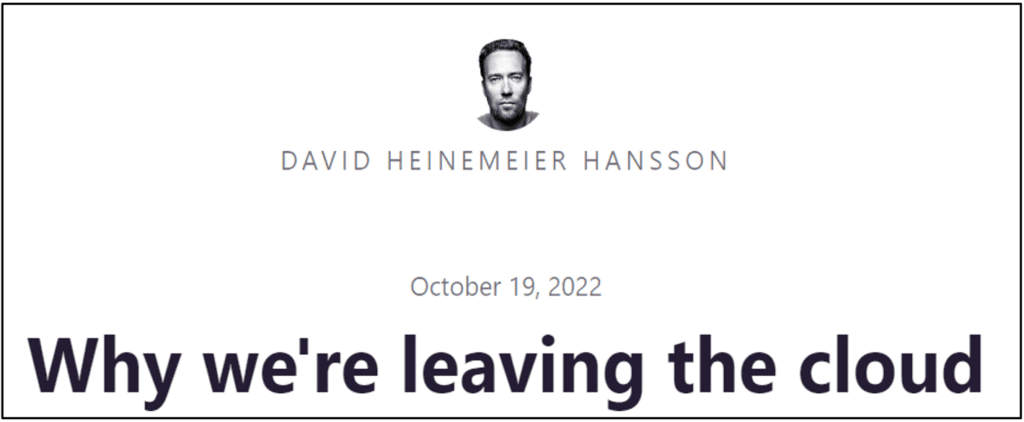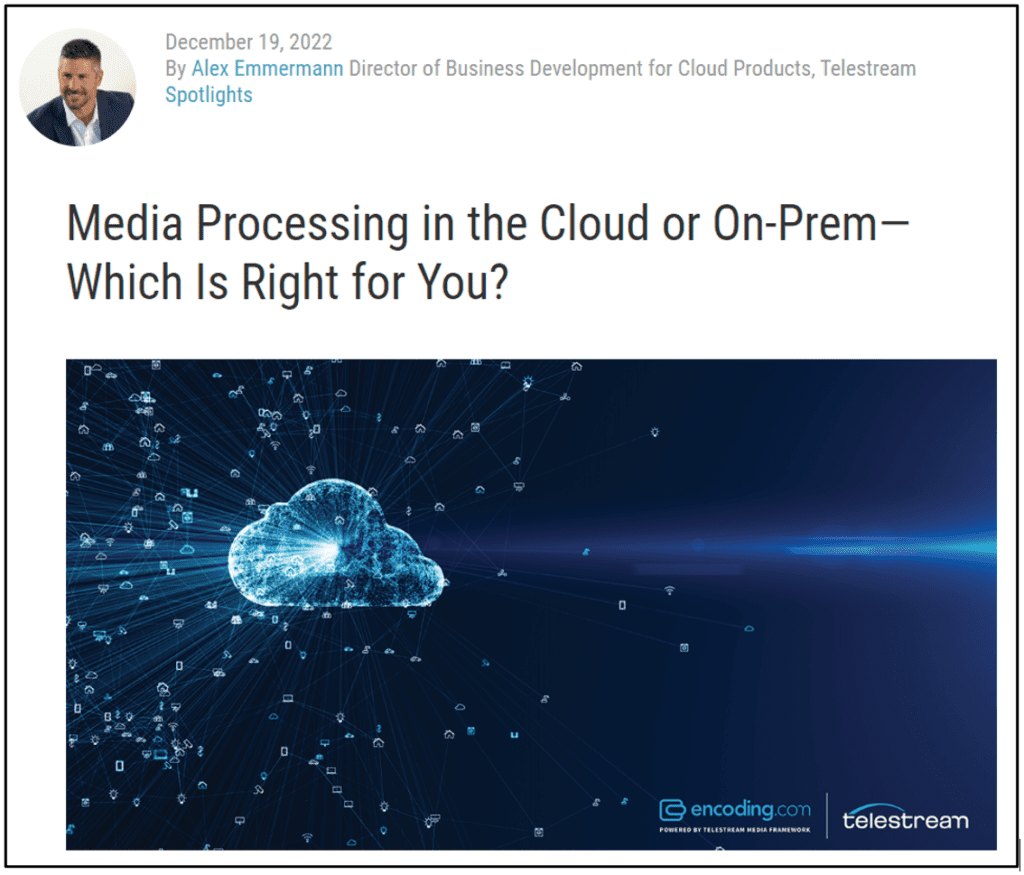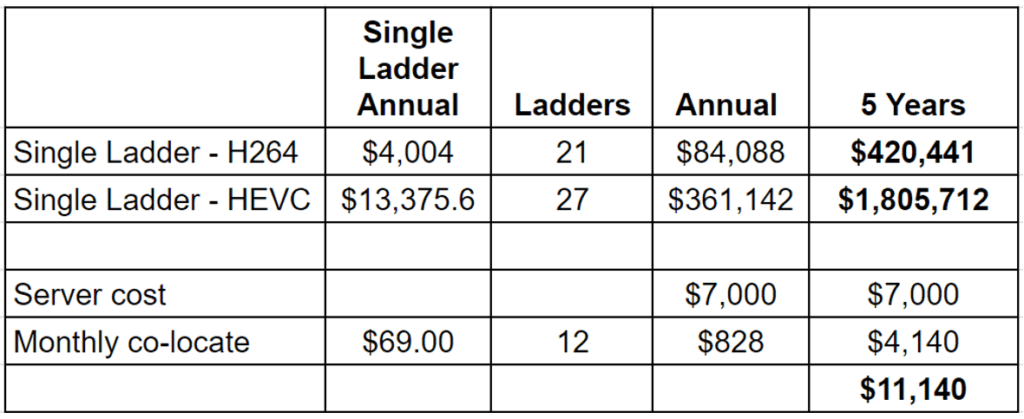Deciding whether to encode on-premise or in the cloud is one of the most critical decisions facing any streaming publisher. Two recent articles provide both strong opinions and insights on this decision and are worthy of review. Our take? Do the math and make your own decision.

The first article is “Why we’re leaving the cloud,” by David Heinemeir Hannson. By way of background, Hansson is co-owner and CTO of software developer 37signals, the developer of the project management platform Basecamp and the premium email service Hey. After running the two platforms on AWS for a number of years, Hannson commented that “renting computers is (mostly) a bad deal for medium-sized companies like ours with stable growth. The savings promised in reduced complexity never materialized.”
As an overview, he asserts that the cloud excels at two ends of the spectrum: 1) simple and low-traffic applications and 2) highly irregular load with wild swings or towering peaks in usage. When Hey first launched, running in AWS allowed the new service to seamlessly onboard the 300,000 users that signed up in the first three weeks, wildly exceeding the forecast of 30,000 in 6 months. However, since then, Hannson reported, these capacity spikes never reoccured, and by “continuing to operate in the cloud, we’re paying an at times almost absurd premium for the possibility that [they] could.”
In abandoning the cloud, Hannson had to stare down two common beliefs. First, is that the cloud simplifies systems and computer management. As it relates to his own businesses, he reports that “anyone who thinks running a major service like HEY or Basecamp in the cloud is “simple” has clearly never tried. Some things are simpler, others more complex, but on the whole, I’ve yet to hear of organizations at our scale being able to materially shrink their operations team just because they moved to the cloud.”
He also tackles perceptions regarding the complexity of running equipment on-premise. “Up until very recently, everyone ran their own servers, and much of the progress in tooling that enabled the cloud is available for your own machines as well. Don’t let the entrenched cloud interests dazzle you into believing that running your own setup is too complicated. Everyone and their dog did it to get the internet off the ground, and it’s only gotten easier since.”

In Media Processing in the Cloud or On-Prem—Which Is Right for You?, Alex Emmermann, Director of Business Development for Cloud Products at Telestream, takes a more moderate view (as you would expect). Emmermann starts by pointing out where the cloud makes sense, zeroing in on the same capacity swings as Hannson. “A typical painful example is when capacity requirements shift underneath you, such as a service becoming more popular than you had initially allocated resources for. For example, when running a media services operation, there are many situations that can stress systems…In media processing, full-catalog licenses, mergers, or content migrations can cause enormous capacity requirements for transcoding and QC.”
Emmermann also introduces the concept of hybrid operations. “For many companies, a wholesale move may feel too risky, so a hybrid approach works well by allowing excess capacity requirements to burst into the cloud as required. This allows run rate systems to continue to function while taking immediate advantage of cloud scaling when and if required. Depending on the needs of the service, a hybrid setup could continue to run indefinitely and very cost effectively if on-prem CapEx resources have already been spent and the resources are in place to keep them running.”
In terms of companies that should operate on-premises, Emmerman cites two examples. First are companies with significant CAPEX investments in encoding gear. “For the many thousands of busy on-premises servers processing run-rate media workflows throughout the world, they’re efficiently and cheaply doing what they need to do and will no doubt continue to do so for a long time.” He also mentions that inexpensive and reliable connectivity is an absolute requirement, and “there are certain places on the planet that may not have reliable interconnectivity to a cloud provider.”
All told, Emmerman concludes, “There’s no question that any media company investing in new services or wanting to have the capacity to say yes to any customer request will want to do this with a public cloud provider…On the other hand, any steady-state, on-premises service that is happily functioning as designed and only occasionally requires a small capital refresh is going to be happy to stay the course.”
Our Take? Do the Math
Anyone who has ever provisioned an EC2 instance from AWS and paid the hourly rate has wondered, “How does that compare to buying your own system?” We’re certainly not immune.
Given the impetus of this article, we decided to put pencil to paper, or keyboard to spreadsheet. We recently launched the NETINT Video Transcoding Server, which costs $7,000 and includes ten T408 transcoders that can output H.264 and HEVC. In benchmarking the entry-level system, it produced 21 five-rung H.264 ladders and 27 4-rung H.264 ladders. What would it cost to produce the same number of streams in AWS?
We checked the MediaLive price list here and confirmed it with the pricing calculator estimate here (Figure 3 for HEVC). Though a single hour of H.264 live streaming costs $0.46, this adds up to $4,004.17/per year. This jumps to $1.527 per hour for HEVC, or $13,375.55 per year. Both are for a single ladder.

Figure 3. Yearly cost for streaming a single five-rung HEVC encoding ladder.
To compare this to our streaming server, we multiplied each ladder by the number of ladders the server could produce and extended all calculations to five years. This translates to a five-year cost of $420,441 for H.264 and a staggering $1,805,712 for HEVC.
To compute the same five-year cost for the server, we added $69/month for colocation charges to the $7,000 base price. This came to $11,140 for either format.

Table 1. Five-year cost comparison, AWS MediaLive pricing compared to the NETINT server.
This comparison brought to mind Hansson’s comment that “Amazon in particular is printing profits renting out servers at obscene margins.” Surely, no streaming publisher is using MediaLive for 24/7 365 operations.
Taking a step back, it’s tough not to agree with the key points from both authors. The cloud does make the most sense when you need instant capacity for peak encoding. For steady-state operations, owning your own gear will always be cheaper.
All that said, no matter what you’re doing in the cloud, run the numbers. While the results probably won’t be as startling as those shown in Table 1, you won’t know until you do the math.
 Streaming Learning Center Where Streaming Professionals Learn to Excel
Streaming Learning Center Where Streaming Professionals Learn to Excel








